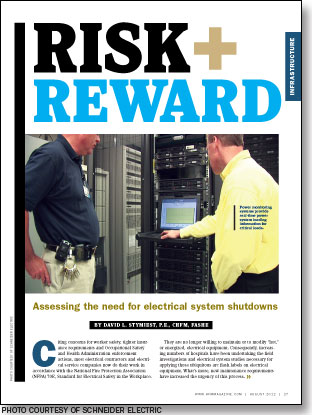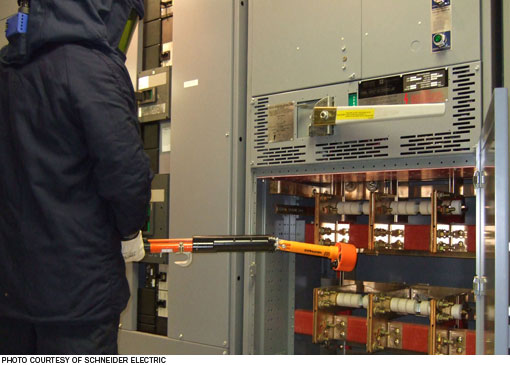
Citing concerns for worker safety, tighter insurance requirements and Occupational Safety and Health Administration enforcement actions, most electrical contractors and electrical service companies now do their work in accordance with the National Fire Protection Association (NFPA) 70E, Standard for Electrical Safety in the Workplace.
They are no longer willing to maintain or to modify "hot," or energized, electrical equipment. Consequently, increasing numbers of hospitals have been undertaking the field investigations and electrical system studies necessary for applying those ubiquitous arc flash labels on electrical equipment. What's more, new maintenance requirements have increased the urgency of this process.
Maintenance game changer
Many hospitals have not been maintaining their electrical equipment. However, recent changes to NFPA 70E may be a game changer. The 2012 edition of NFPA 70E requires maintenance of electrical distribution system equipment in accordance with manufacturers' instructions or industry consensus standards.
According to 205.3, General Maintenance Requirements, for instance, "Electrical equipment shall be maintained in accordance with manufacturers' instructions or industry consensus standards to reduce the risk of failure and the subsequent exposure of employees to electrical hazards." Likewise, according to 205.4, Overcurrent Protective Devices, "Overcurrent protective devices shall be maintained in accordance with the manufacturers' instructions or industry consensus standards. Maintenance, tests, and inspections shall be documented."
Manufacturers' operating and maintenance manuals should accompany all new equipment. Most existing equipment also has maintenance recommendations still available, many of them on the Internet. In fact, the original operating and maintenance manuals may have been updated since they originally were written to reflect years of additional operating experience with the equipment — a good reason to see if archived manuals have been modified since equipment first was installed. Manufacturers' service organizations, electrical testing companies and other firms often can provide this input.
One industry consensus standard mentioned in the 2012 NFPA 70E handbook, called "Handbook for Electrical Safety in the Workplace," is NFPA 70B, Recommended Practice for Electrical Equipment Maintenance, which was last updated in 2010. Another such standard is the "American National Standards Institute/InterNational Electrical Testing Association (ANSI/NETA) Standard for Maintenance Testing Specifications for Electrical Power Equipment and Systems," which was updated last in 2011. There are differences between those two documents, but they are both excellent resources. And they are both regularly updated by their sponsoring organizations.
The NFPA 70E handbook also mentions ANSI/National Electrical Manufacturers Association (NEMA) AB4, Guidelines for Inspection and Preventive Maintenance of Molded-Case Circuit Breakers Used in Commercial and Industrial Applications, as a source of information regarding inspection and maintenance of molded-case circuit breakers, a common type of overcurrent protective device used in hospitals.
Although not mentioned within the NFPA 70E Handbook as an industry consensus standard, another useful reference is the Institute of Electrical and Electronics Engineers (IEEE) 902 "IEEE Guide for Maintenance, Operation, and Safety of Industrial and Commercial Power Systems" (also called the "IEEE Yellow Book") that was last updated in 1998.
Chapter 8 of NFPA 110, Standard for Emergency and Standby Power Systems, also requires regular inspection, testing and maintenance of generators, automatic transfer switches and paralleling gear.
Shutdown risk assessments
Many organizations perceive electrical shutdowns to be a potential patient safety risk and are unwilling to conduct those that they believe are not absolutely required by a construction/renovation (C/R) project. This approach masks the fact that lack of maintenance shutdowns also can introduce worker safety hazards and can introduce additional patient safety risk by lowering operational reliability. One source defines operational reliability as the probability that a system or item of equipment will operate properly in the next second and the one after that.
One way to consider both the positive and negative aspects of conducting shutdowns for electrical equipment maintenance is to perform a maintenance shutdown risk assessment following the Joint Commission's familiar risk assessment process. Hospitals are comfortable with conducting risk assessments to manage other types of risk: Why not conduct them for electrical maintenance shutdowns? These seven steps provide examples of the issues that might be included in such a risk assessment:
Step 1 Identify the issue. If an organization's current practice consists simply of annual thermographic (infrared) inspections and the inspection reports indicate the need for immediate or high-priority repairs or adjustments, that work is undertaken using corrective work orders. The issue may be whether to expand that current practice to include a new program of proactive electrical equipment preventive maintenance (PM) that requires carefully managed electrical shutdowns of the normal power system.
A totally separate but analogous issue could be whether to establish a program of localized maintenance shutdowns of one or more essential electrical system branches for life safety, critical or equipment operations. This type of shutdown may be necessary for full maintenance on an automatic transfer switch that does not have an optional bypass-isolation feature. These branch shutdowns often are considered more difficult and riskier than normal power shutdowns because they focus on the highest acuity areas due to the nature of their connected loads. This type of shutdown could be somewhat localized because it probably would be managed to affect only one automatic transfer switch at a time.

Personal protective equipment is required until electrical equipment is placed into an electrically safe work condition at the start of a shutdown.
Step 2 Develop arguments for the issue. There are many arguments that support conducting maintenance shutdowns. For example, electrical equipment that probably has been operating 24/7 since installation is now 20 or more years old and has never been maintained. Other arguments include concerns that one or more circuit breakers may not be able to open to trip a fault (short circuit) should one occur. There also may be concerns about insulation breakdown or a potential failure because infrared scanning results have shown an increasing incidence of hot spots.
The hospital also may be concerned that users are not adequately prepared for real power outages since they have not previously dealt with any actual electrical outages. The American Society for Healthcare Engineering (ASHE) annual conference white paper and Management Monograph on "Managing Hospital Electrical Shutdowns" listed in the sidebar on page 31 discusses a detailed approach that allows the hospital's shutdown management activities to be used to improve its emergency management features — planning, mitigation, response and recovery — related to power failures. A side benefit of planned electrical shutdowns is that they allow hospitals to assess the operating capabilities of the facility's clinical and support services during utility power outages.
Perhaps the hospital performed a power system vulnerability analysis that has highlighted the lack of maintenance as a point of increasing system vulnerability. Finally, an authority having jurisdiction such as the Centers for Medicare & Medicaid Services may have issued a deficiency finding regarding the lack of maintenance in compliance with an equipment manufacturer's recommended maintenance schedule.
Step 3 Develop arguments against the issue. Arguments that do not support starting a program of electrical maintenance shutdowns could include that the normal power system serving the area has an excellent operational history, has not had any failures and does not appear to be in need of intervention. Other reasons may be that the equipment is relatively new and assumed to be able to go several more years before the first maintenance shutdown is even considered.
In some hospitals, facilities management or administration may be concerned that the equipment may not be able to go back online once it is turned off, thus resulting in a prolonged outage. A second concern may be that something can go wrong during the normal power shutdown, such as a generator failure.
Another concern may be related to the hospital emergency power gap analysis that was performed in response to the Joint Commission's 2006 "Sentinel Event Alert Issue 37: Preventing adverse events caused by emergency electrical power system failures" — an important system or item of equipment is still not connected to emergency power and would not be operating during any planned normal power shutdown.
Step 4 Objectively evaluate both sets of arguments. Objectivity is crucial during this step. It helps to have empirical evidence to support each argument. There are many types of empirical evidence that may be available. These could include operational documentation such as utility failure incident reports or corrective maintenance work orders. Thermographic inspection findings and trends from the past few annual inspections can be useful. Because it is probable that the facility has been conducting isolated C/R project shutdowns, perhaps the findings and lessons learned from those shutdowns also will provide objective evidence of the pros and cons related to maintenance shutdowns.
Industry codes, standards and recommendations such as those contained in NFPA 70E, NFPA 70B, the ANSI/NETA Maintenance Testing Specifications, IEEE 902, and ANSI/NEMA AB-4 also can be helpful in assessing the impact of a PM shutdown program. Manufacturers' recommendations also should be consulted because they can have an impact on the evaluation.
Other types of useful empirical evidence can include utility equipment-failure backup policies, plans and procedures including those developed by clinical units and support services for power failures. Evaluation also may include revisiting or updating the sort of power system vulnerability analyses or emergency power gap analyses discussed in the Joint Commission's Sentinel Event Alert Issue 37.
Step 5 Reach a conclusion. There are many conclusions that can result from this sort of risk assessment. Some facilities may decide to bite the bullet and commence a new electrical PM program, recognizing that safe electrical shutdowns are complex undertakings that often require significant financial and personnel resources. Other facilities may decide to start small with localized area shutdowns in the highest-priority areas or with the oldest or neediest equipment. This approach is a way for the facility to evaluate the process. It allows leadership to become comfortable with the comprehensiveness of the shutdown management process. Yet, other facilities may decide to take no additional action with regard to electrical PM. Some health care organizations may decide to take different actions at different facilities depending on the facility-specific needs.
Regardless of the conclusions reached, an additional measure may be for the organization to establish a policy that all future C/R electrical shutdowns will allow time for maintenance of the equipment that is turned off before it is turned on again. Another additional conclusion could be to require that future C/R designs include systems and equipment that are easily maintained and shutdown-friendly. The conclusions should address the full issue being analyzed and not just portions of it.
Step 6 Document the risk assessment process. This type of risk assessment falls under the heading of managing risk for the environment of care. As such, it should be reported to and followed up by the hospital's safety committee or environment of care committee. Decisions made because of this process may result in policies or procedures that then could fall under the hospital's utility systems management plan.
Step 7 Monitor and reassess the conclusion to ensure the best decision. Because a risk assessment of this importance can have conclusions with wide-ranging impact, it is important to include a specific date to reassess its conclusions. An organization should evaluate the results to ensure that actions taken as a result of the risk assessment did, indeed, have the positive results that were anticipated.
Establishing salient points
Depending on decisions by authorities having jurisdiction, the recent changes in NFPA 70E may be requiring additional electrical maintenance shutdowns by some organizations.
Electrical maintenance should never be done with the equipment hot. Attempting to maintain energized equipment is ill-advised, dangerous and can lead to an unexpected power outage, adversely impacting both patient and worker safety.
This maintenance shutdown risk assessment approach can assist hospitals in establishing the salient points for considering electrical equipment inspection, testing and maintenance programs.
David L. Stymiest, P.E., CHFM, FASHE, is a senior consultant at Smith Seckman Reid, specializing in facilities engineering and compliance consulting. He can be reached at DStymiest@SSR-inc.com. Although Stymiest is chairman of the NFPA technical committee on emergency power supplies, which is responsible for NFPA 110 and 111, the views and opinions expressed in this article are purely those of the author and shall not be considered the official position of NFPA or any of its technical committees, and shall not be considered to be, nor be relied upon as, a formal interpretation of the discussed standards.
Sidebar - Need more info? Go to the sources.



